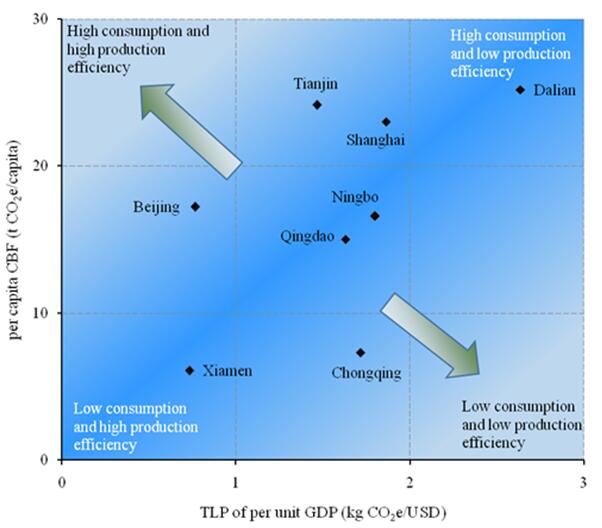Cites generate about 70% of global greenhouse gas emissions. Therefore Cities have large advantages in implementing greenhouse gas (GHG) reduction actions economically, socially, and polically. The production and consumption activities of cities can extend to the upstream hinterland and downstream customers. This extension embodied in producing and processing basic materials such as imported energy, food, water, and construction materials, and final products consumed by local and nonlocal consumers. At present it lacks comprehensive characterization of urban system in terms of carbon emissions and carbon footprint and thereby, lacks accurate and thorough evaluation and comparison of low carbon cities and emission reduction strategy analysis.
Urban ecological process and the control research group(Shenghui Cui’ research team), Institute of Urban Environment, Chinese Academy of Sciences, established complete evaluation model, and quantified the emissions within the city boundary, emissions embodied in import (EEI) and emissions embodied in export (EEE) with the combination of bottom-up and top-down method, defined four kinds of footprints and four measure criteria of low-carbon city according to different policy relevance and preliminarily summarized the common features of urban carbon footprint. Eight typical rapid developing and active trading cities(such as Beijing, Xiamen, etc) in China were selected as study cases. The results showed that: (1) By comparing the four kinds of accountings of carbon footprint (CF), most of EEI came from imported energy, steel, cement and other primary products of the developing or underdeveloped regions of mainland China (MC), and most of the EEE footprint was embodied in carbon-intensive products and services flowing to MC, principal North American countries and Europe, etc. (2) Evaluation of low-carbon cities need to integrate four criteria of the carbon production intensity(CPI), the carbon consumption level (CCL) the balance of import and export (BIE) and balance of trade intensity (BTI) of the cities. (3) Construction was the largest consumer of carbon, consuming embodied carbon from the electrical, non-metallic materials and primary metal sectors of cities. (4) The CPI of upstream producers will ultimately affect CPI of the urban final products and CCL of urban residents. Improving the production level of China and other developing countries can help to reduce the carbon intensity of principal basic raw materials and then improve the production efficiency of the city in the perspective of life cycle. The methods established in this study can be well copied to other cities with compiled input-output tables, and benefit the research of urban carbon footprint and provide standard for comparing basic features of urban carbon footprint in the process of urbanization.
Related research results were published in international journals of the field of environmental science, Environmental Research Letters and Environmental Science & Technology. This study was supported by the National Natural Science Foundation of China (71003090 and 71273252), the National Key Technology R&D Program of the Ministry of Science and Technology (2012BAC21B03), China Scholarship Council (201404910215) and the US National Science Foundation PIRE Program.
The full text links below: http://dx.doi.org/10.1088/1748-9326/10/5/054001;
http://pubs.acs.org/doi/abs/10.1021/acs.est.6b00985。

Composition and boundaries of various components and methods for calculating the urban carbon footprint.

Development patterns of eight Chinese cities from the perspectives of carbon production efficiency and consumption levels.

Composition of the construction sector’s consumed carbon footprint Note: 1. The gridded bars were the largest carbon inflow sectors (Mt CO2e); 2. The percentage after each city was the share in PBF (%)